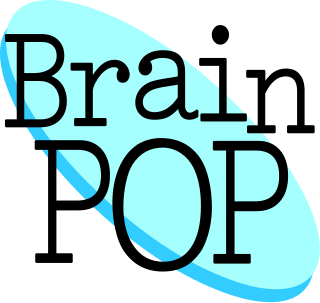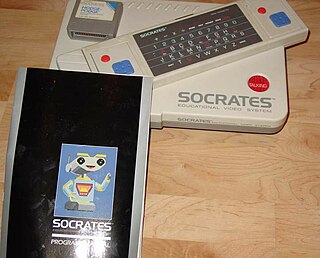Multimedia is content that uses a combination of different content forms such as text, audio, images, animations, video and interactive content. Multimedia contrasts with media that use only rudimentary computer displays such as text-only or traditional forms of printed or hand-produced material.
Educational software is a term used for any computer software which is made for an educational purpose. It encompasses different ranges from language learning software to classroom management software to reference software, etc. The purpose of all this software is to make some part of education more effective and efficient.
Educational games are games explicitly designed with educational purposes, or which have incidental or secondary educational value. All types of games may be used in an educational environment, however Educational games are games that are designed to help people learn about certain subjects, expand concepts, reinforce development, understand a historical event or culture, or assist them in learning a skill as they play. Game types include board, card, and video games. As educators, governments, and parents realize the psychological need and benefits that gaming has on learning, this educational tool has become mainstream. Games are interactive play that teach us goals, rules, adaptation, problem solving, interaction, all represented as a story. They satisfy our fundamental need to learn by providing enjoyment, passionate involvement, structure, motivation, ego gratification, adrenaline, creativity, social interaction and emotion in the game itself while the learning takes place.

The Oregon Trail is a text-based strategy video game developed by Don Rawitsch, Bill Heinemann, and Paul Dillenberger in 1971 and produced by the Minnesota Educational Computing Consortium (MECC) beginning in 1975. It was developed by the three as a computer game to teach school children about the realities of 19th-century pioneer life on the Oregon Trail. In the game, the player assumes the role of a wagon leader guiding a party of settlers from Independence, Missouri, to Oregon City, Oregon via a covered wagon in 1847. Along the way the player must purchase supplies, hunt for food, and make choices on how to proceed along the trail while encountering random events such as storms and wagon breakdowns. The original versions of the game contain no graphics, as they were developed for computers that used teleprinters instead of computer monitors. A later Apple II port added a graphical shooting minigame.

ILOVEYOU, sometimes referred to as Love Bug or Love Letter for you, is a computer worm that infected over ten million Windows personal computers on and after 4 May 2000 when it started spreading as an email message with the subject line "ILOVEYOU" and the attachment "LOVE-LETTER-FOR-YOU.txt.vbs". The latter file extension was most often hidden by default on Windows computers of the time, leading unwitting users to think it was a normal text file. Opening the attachment activates the Visual Basic script. The worm inflicts damage on the local machine, overwriting random types of files, and sends a copy of itself to all addresses in the Windows Address Book used by Microsoft Outlook. This made it spread much faster than any other previous email worm.

BrainPop is a group of educational websites with over 1,000 short animated movies for students in grades K-12, together with quizzes and related materials, covering the subjects of science, social studies, English, math, engineering and technology, health, and arts and music. BrainPop is used in more than 20% of U.S. schools and also offers subscriptions for families and homeschoolers. It is also used in schools in Mexico, France, Spain, Israel and several other countries, where it offers videos in local languages that are designed for students in those countries. BrainPop is available by subscription but has some free content, including a movie of the day, several free movies from each topic area, educators materials, including lesson plans, and an extensive library of educational games called GameUp. Its free smartphone and tablet application accesses BrainPop's free and subscription content.
Educational technology is the combined use of physical hardware, software, and educational theory and practice to facilitate learning. Educational technology creates, uses, and manages technological processes and educational resources to help improve user academic performance. The field has been described as a persisting initiative that seeks to bring learners, teacher, and technical means together in an effective way.
Technology integration is the use of technology tools in general content areas in education in order to allow students to apply computer and technology skills to learning and problem-solving. Generally speaking, the curriculum drives the use of technology and not vice versa. Technology integration is defined as the use of technology to enhance and support the educational environment. Technology integration in the classroom can also support classroom instruction by creating opportunities for students to complete assignments on the computer rather than with normal pencil and paper. In a larger sense, technology integration can also refer to the use of an integration platform and APIs in the management of a school, to integrate disparate SaaS applications, databases, and programs used by an educational institution so that their data can be shared in real-time across all systems on campus, thus supporting students' education by improving data quality and access for faculty and staff.
"Curriculum integration with the use of technology involves the infusion of technology as a tool to enhance the learning in a content area or multidisciplinary setting... Effective integration of technology is achieved when students are able to select technology tools to help them obtain information in a timely manner, analyze and synthesize the information, and present it professionally to an authentic audience. The technology should become an integral part of how the classroom functions—as accessible as all other classroom tools. The focus in each lesson or unit is the curriculum outcome, not the technology."
Synchronous conferencing is the formal term used in computing, in particular in computer-mediated communication, collaboration and learning, to describe technologies informally known as online chat. It is sometimes extended to include audio/video conferencing or instant messaging systems that provide a text-based multi-user chat function. The word synchronous is used to qualify the conferencing as real-time, as distinct from a system such as e-mail, where messages are left and answered later.

An educational video game is a video game that provides learning or training value to the player. Edutainment describes an intentional merger of video games and educational software into a single product. In the narrower sense used here, the term describes educational software which is primarily about entertainment, but tends to educate as well and sells itself partly under the educational umbrella. Normally software of this kind is not structured towards school curricula and does not involve educational advisors.
A serious game or applied game is a game designed for a primary purpose other than pure entertainment. The "serious" adjective is generally prepended to refer to video games used by industries like defense, education, scientific exploration, health care, emergency management, city planning, engineering, and politics. Serious games are a subgenre of serious storytelling, where storytelling is applied "outside the context of entertainment, where the narration progresses as a sequence of patterns impressive in quality ... and is part of a thoughtful progress". The idea shares aspects with simulation generally, including flight simulation and medical simulation, but explicitly emphasizes the added pedagogical value of fun and competition.
Social learning tools are tools used for pedagogical and andragogical purposes that utilize social software and/or social media in order to facilitate learning through interactions between individuals and systems. The idea of setting up "social learning tools" is to make education more convenient and widespread. It also allows an interaction between users and/or the software which can bring a different aspect to learning. People can acquire knowledge by distance learning tools, for instance, Facebook, Twitter, Khan Academy and so on. Social learning tools may mediate in formal or informal learning environments to help create connections between learners, instructors and information. These connections form dynamic knowledge networks. Social learning tools are used in schools for teaching/learning and in businesses for training. Within a school environment, the use of social learning tools can affect not only the user (student) but his/her caretaker as well as his/her instructor. It brings a different approach to the traditional way of learning which affects the student and his/her support circle. Companies also use social learning tools. They used them to improve knowledge transfer within departments and across teams. Businesses use a variety of these tools to create a social learning environment. They are also used in company settings to help improve team work, problem solving, and performance in stressful situations.

Computers in the classroom include any digital technology used to enhance, supplement, or replace a traditional educational curriculum with computer science education. As computers have become more accessible, inexpensive, and powerful, the demand for this technology has increased, leading to more frequent use of computer resources within classes, and a decrease in the student-to-computer ratio within schools.

Edmodo is an educational technology company offering a communication, collaboration, and coaching platform to K-12 schools and teachers. The Edmodo network enables teachers to share content, distribute quizzes, assignments, and manage communication with students, colleagues, and parents. Edmodo is very teacher-centric in their design and philosophy: students and parents can only join Edmodo if invited to do so by a teacher. Teachers and students spend large amounts of time on the platform, both in and out of the classroom. Edmodo is free to use, but it also offers premium services.
This page includes some history of video games being used as an additional or alternative method to traditional education. This page presents why using video games are beneficial to use for educational purposes in the classroom as well as the limitations. This page additionally discusses how learning from video games outside the classroom is possible as well.

The gamification of learning is an educational approach to motivate students to learn by using video game design and game elements in learning environments. The goal is to maximize enjoyment and engagement through capturing the interest of learners and inspiring them to continue learning. Gamification, broadly defined, is the process of defining the elements which comprise games that make those games fun and motivate players to continue playing, and using those same elements in a non-game context to influence behaviour. In other words, gamification is the introduction of game elements in a non-game situation.

Kahoot! is a game-based learning platform, used as educational technology in schools and other educational institutions. Its learning games, "Kahoots", are user-generated multiple-choice quizzes that can be accessed via a web browser or the Kahoot app.

The COVID-19 pandemic has affected educational systems worldwide, leading to the near-total closures of schools, universities and colleges.
Zoombombing, Zoom-bombing or Zoom raiding is the unwanted intrusion into a video conference call by an individual, causing disruption. The term became popularized in 2020, after the COVID-19 pandemic forced many people to stay at home and videoconferencing is used on a large scale by businesses, schools, and social groups. The term is associated with and derived from the name of the Zoom videoconferencing software program but it has also been used to refer to the phenomenon on other video conferencing platforms.
Crystal Island: Uncharted Discovery is an educational video game created by a team of educators and computer scientists at the Center for Educational Informatics aimed at teaching students upper elementary science education, focusing on landforms, navigation, and modeling. In the game, students play as shipwrecked adventurers on a volcanic island. To escape the island, they must complete a series of quests that test their critical thinking skills and teach them content-related information. Upon completion of the quests, the players gain access to a new area of the island which contains a multi-skill quest that requires students to use the knowledge and skills they learned during the previous quests. Once the final quest is completed, the players gain access to a communication device which allows them to call the outside world for rescue. The game was made with the Unity game engine. It was made by the same creators of the game Crystal Island: Lost Investigation.








